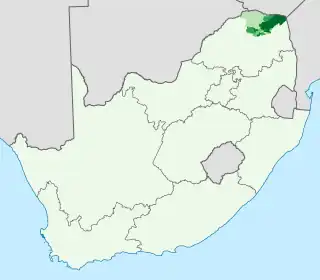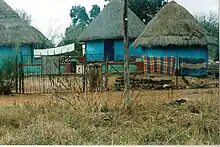Venda people
The Venḓa (VhaVenḓa or Vhangona) are a Southern African Bantu people living mostly near the South African-Zimbabwean border. The Venda language arose from interactions with Sotho-Tswana and Kalanga initiates during the 15th century in Zimbabwe.[4]
 | |
| Total population | |
|---|---|
| ~2.5 million | |
| Regions with significant populations | |
| [1][2] | |
| [3] | |
| Languages | |
| Tshi-Venda | |
| Religion | |
| Christianity, Traditional African religion | |
| Related ethnic groups | |
| Makua people, Shona people, Sotho-Tswana peoples, and Kalanga people | |
The history of the Venda starts from the Kingdom of Mapungubwe (9th Century) where King Shiriyadenga was the first king of Venda and Mapungubwe.[5] The Mapungubwe Kingdom stretched from the Soutpansberg in the south, across the Limpopo River to the Matopos in the north. The Kingdom declined from 1240, and power moved north to the Great Zimbabwe Kingdom. The first Venda settlement in the Soutpansberg was that of the legendary chief Thoho-ya-Ndou (Head of the Elephant). His royal kraal was called D’zata; its remains have been declared a National Monument. The Mapungubwe Collection is a museum collection of artefacts found at the archaeological site and is housed in the Mapungubwe Museum in Pretoria. Venda people share ancestry with Lobedu people and Kalanga people. They are also related to Sotho-Tswana peoples Sotho-Tswana and Shona groups. All these tribes were under the Venda kingdom.
History
The Venda of today are Vhangona, Takalani (Ungani), Masingo and others. Vhangona are the original inhabitants of Venda, they are also referred as Vhongwani wapo; while Masingo and others are originally from central Africa and the East African Rift, migrating across the Limpopo river during the Bantu expansion, Venda people originated from central and east Africa, just like the other South African tribes.[6][7]
Clans
The Venda of today are descendants of many heterogeneous groupings and clans such as:
- Dzindou dza Hakhomunala Mutangwe /
Dzatshamanyatsha - Dzindou dza Vharundwa /
Dza Mitshetoni /Dza Manenzhe - Vhafamadi;
- Vhadau vhatshiheni
- Vhadau Madamani
- Rambuda;
- Vha Ha-Ramavhulela (Vhubvo Dzimauli)
- Vhakwevho;
- Vha Ha-Maďavha (Great Warthogs of Luonde
who immigrated from Zimbabwe) - Vhambedzi;
- Vhania;
- Vhagoni;
- Vhalea;
- Gebebe;
- Ndou;
- Maďou;
- Vhasekwa;
- Vhaluvhu;
- Vhatavhatsindi;
- Vhalovhedzi
- VhaMese
- Vha Ha-Nemutudi
- Vhatwanamba;
- Vhanzhelele/Vhalembethu;
- VhaDzanani
- Vhanyai;
- Vhalaudzi;
- Masingo; and Rambau
- Runganani (marungadzi nndevhelaho)
- Takalani(Ungani)
Vhadau, Vhakwevho, Vhafamadi, Vhania, Vhalea, and Vhaluvhu were collectively known as Vhangona. The Vhangona and Vhambedzi are considered to be the original inhabitants of Venda and the first people to live there.
The land of Vhangona was later settled by Karanga-Rodzvi clans from Zimbabwe: Vhatwanamba, Vhanyai, Vhatavhatsindi, and Vhalembethu. Masingo and Vhalaudzi are late arrivals in Venda.
Districts
According to one version of Vhangona oral history the capital of Vhangona was Mapungubwe with the Raphulu Royal House as the most senior royal house of the Vhangona. According to this version the Vhangona Kingdom had approximately 145 chiefdoms and a King (Thovhele). It is said that the Kingdom was divided into seven districts:
- Dzanani
- Mbilwi
- Tswime
- Tshiendeulu
- Tshakhuma
- Tshamanyatsha
- Lwamondo
These districts were ruled by District Paramount Chiefs (Mahosi Mahulu), as follows:
- Mudzanani/Nesongozwi (Dzanani)
- Nembilwi (Mbilwi)
- Netswime (Tswime)
- Netshiendeulu (Tshiendeulu)
- Netshakhuma (Tshakhuma)
- Netshamanyatsha (Tshamanyantsha)
- Makhahani (Thulamela)
- Nelwamondo (Lwamondo)
Each district had Chiefs (Khosi) who paid tribute to Mahosi Mahulu (Paramount Chiefs), then there were Headmen (VhaMusanda) and then Petty Headmen (Vhakoma). This tradition states that one of the Vhangona kings was King Shiriyadenga whose royal kraal was at Mapungubwe. It is not clear if this Shiriyadenga is the same as Shiriyedenga of the Sanga dynasty, a Karanga-Rozvi branch. The Sanga dynasty, in Zimbabwe's eastern highlands, was founded by Chiphaphami Shiriyedenga who died in 1672. Perhaps at one point the Karanga-Rodzvi Empire extended beyond the Vhembe (Limpopo) River, and the Vhangona, though not Karanga-speaking, were at one point under Karanga-Rodzvi rule.
The other version of Vhangona history disputes that the Vhangona were ever united under one chief or king. It says that the Vhangona had different independent chiefdoms and that the Vhangona chief of Nzhelele valley was Tshidziwelele of the Mudau clan. What is clear, however, is that the Vhatwanamba, who were of Karanga-Rodzvi origin, conquered Vhangona clans who lived in Mapungubwe, Musina, Ha-Tshivhula, Ha-Lishivha, Ha-Matshete, Ha-Mulambwane, and Ha-Madzhie (the areas of Ha-Tshivhula, Ha-Lishivha, Ha-Matshete, and Ha-Mulambwane are known today as Alldays and Waterpoort).
Mapungubwe
Mapungubwe was the center of a kingdom with about 5,000 people living at its center. Mapungubwe as a trade center lasted between 1030 and 1290 AD. The people of Mapungubwe mined and smelted copper, iron and gold, spun cotton, made glass and ceramics, grew millet and sorghum, and tended cattle, goats and sheep.
The people of Mapungubwe had a sophisticated knowledge of the stars, and astronomy played a major role not only in their tradition and culture, but also in their day-to-day lives. Mapungubwe traded with ancient Ethiopia through the ports of Adulis on the Red Sea and the ports of Raphta (now Quelimani) and Zafara (now Sofala) in Mozambique.
Mapungubwe predates the settlements at Great Zimbabwe, Thulamela and Dzata. It is believed that people left Mapungubwe for Great Zimbabwe because Great Zimbabwe was judged to have a more suitable climate.
Venda royal house
The Venda were recognised as a traditional royal house in 2010 and Toni Mphephu Ramabulana has been acting king since 2012. In September 2016 Princess Masindi Mphephu, daughter of Tshimangadzi Mphephu (Venda Chief during 1993–1997), challenged her uncle Ramabulana for the throne. She claimed that she wasn't considered a candidate because of her sex.[8]
On 14 December 2016 she initially lost this battle in court when the Thohoyandou High Court dismissed the case.[9] In May 2019, however, the Supreme Court of Appeal overturned the Thoyoyandou High Court decision and declared that Toni Mphephu-Ramabulana's appointment as king of the Venda nation was unlawful.[10] Ramubulana has since appealed this ruling, and as of July 2020 the matter was before the Constitutional Court of South Africa.[11]
Notable Venda people

The following is a list of notable Venda people who have their own Wikipedia articles.
D
- Benedict Daswa, South African school teacher beatified by the Roman Catholic Church
- Mulalo Doyoyo, South African engineer, inventor, and professor
G
- Thomas Gumbu, South African politician
K
- Mmbara Hulisani Kevin, South African politician
L
- Mavhungu Lerule-Ramakhanya, South African politician
Ma-Mp
- Noria Mabasa, Venda artist who works in ceramic and wood sculpture
- E. S. Madima, South African writer
- Tenda Madima, South African writer
- Joe Mafela, South African actor, film director and singer
- Makhado, 19th century King of the Venda people
- Milicent Makhado, South African actress
- Rudzani Maphwanya, South African Army officer
- Tshilidzi Marwala, Vice-Chancellor of the University of Johannesburg, South African engineer and computer scientist
- Florence Masebe, South African actress
- Michael Masutha, South African politician
- Rendani Masutha, South African naval officer and former military judge
- Shaun Maswanganyi, South African athlete
- Mark Mathabane, South African tennis player and author of Kaffir Boy
- Eric Mathoho, South African footballer
- Kembo Mohadi, Vice President of Zimbabwe.
- Patrick Mphephu, first president of the bantustan of Venda
Mu
- Daniel Mudau, South African footballer
- Khuliso Mudau, South African footballer
- Sydney Mufamadi, South African politician
- Fulu Mugovhani, South African actress
- Mukhethwa Mukhadi, South African singer, rapper, producer and director
- Elaine Mukheli, South African singer and songwriter
- Colbert Mukwevho, South African reggae singer
- Gumani Mukwevho, South African politician
- Collen Mulaudzi, South African long-distance runner
- Mbulaeni Mulaudzi, South African middle-distance runner
- Rhoda Mulaudzi, South African footballer
- Rotshidzwa Muleka, South African footballer
- Luvhengo Mungomeni, South African footballer
- Clarence Munyai, South African sprinter
- Marks Munyai, South African footballer
- Tshifhiwa Munyai, South African boxer
- Azwinndini Muronga, South African physicist
- Shudufhadzo Musida, Miss South Africa 2020 winner
- Faith Muthambi, South African politician
N
- Phathutshedzo Nange, South African footballer
- Phillip Ndou, South African boxer
- Lovemore Ndou, South African-Australian boxer
- Prince Neluonde, South African lawn bowler
- Fulufhelo Nelwamondo, South African engineer and computer scientist
- Tshilidzi Nephawe, South African basketball player
- Joel Netshitenzhe, South African politician
- Khumbudzo Ntshavheni, South African politician
P
- George Phadagi, South African politician
- Fred Phaswana, South African businessman
R
- Kagiso Rabada, South African cricketer
- Rodney Ramagalela, South African footballer
- Cyril Ramaphosa, 5th President of the Republic of South Africa
- Richard Ramudzuli, South African Events Organizer
- Gabriel Ramushwana, former head of state of the bantustan of Venda
- Phophi Ramathuba, South African politician and medical doctor
- Rudzani Ramudzuli, South African footballer
- Khume Ramulifho, South African politician
- Ndivhudzannyi Ralivhona, South African musician
- Rasta Rasivhenge, South African rugby union referee
- Frank Ravele, second president of the bantustan of Venda
- Riky Rick, South African rapper, songwriter and actor
T
- Gabriel Temudzani, South African actor
- Dan Tshanda, South African musician
- Mashudu Tshifularo, South African educator and medical specialist
- Jacob Tshisevhe, South African footballer
- Mpho Tshivhase, South African philosopher
W
- Ernst Oswald Johannes Westphal, Professor of African Languages, b. Khalavha 1919
Musangwe
Musangwe is a Venda tradition of bare-knuckle fist fighting. Musangwe is a sport which was developed not only for entertainment but also for gaining respect among your peers. Vhavenda never allowed violence and fighting, but with this sport you could challenge a person you deemed disrespectful towards you, and the rule is if you are challenged to fight you are to fight or there will be consequences such as a fine or even been beaten up by the elders. The winners of this sport were often compensated with whatever the Khosi (chief) or Vhamusanda (headman) deemed right.[12][13][14] The fights have no set time limit and only end when one fighter concedes defeat. No medical staff are on standby to help those injured in the flurry of blows that boxers trade, only village elders watching to guard against indiscretions such as biting or kicking. Importantly, gambling on the outcome of the fights is banned and the winners take nothing away other than a sense of pride in representing their village or family.[15]
References
- "South africa – Tsonga and Venda". Country Studies. Retrieved 9 October 2008.
- "Vhavenda People". Pilot Guides. Retrieved 9 October 2008.
- "INDIGENOUS PEOPLES ARCHIVE - VHAVENDA". Intercontinental Cry. Archived from the original on 4 January 2015. Retrieved 1 April 2015.
- Huffman, Thomas N.; Woodborne, Stephan (August 2021). "Implications of new AMS dates for the Khami Period in the Mapungubwe Landscape". South African Journal of Science. 117 (7–8): 1–5. doi:10.17159/sajs.2021/9438. ISSN 0038-2353.
- "Venda - African Tribe". krugerpark.co.za. Retrieved 16 June 2021.
- "Venda | African Tribes". Kruger National Park. Retrieved 9 October 2008.
- "Vha Venda Culture". Alliance Française. Archived from the original on 16 June 2008. Retrieved 9 October 2008.
- "Battle for VhaVenda throne continues". enca.com. 14 December 2016. Retrieved 18 December 2016.
- "Princess Masindi Mphephu loses court bid". msn.com. Archived from the original on 20 December 2016. Retrieved 18 December 2016.
- "Mphephu royal family accepts court ruling". The Sowetan.
- "VhaVenda royal fight heads to Constitutional Court". 22 July 2020.
- Wende, Hamilton (5 February 2011). "South African boxing that 'makes the heart strong'". BBC. Retrieved 6 February 2011.
- eDuzeNet. "Musangwe -The Mysterious Venda Combat". Bulawayo24 News. Retrieved 19 October 2018.
- Shalati Nkhwashu (21 February 2011). "It's jaw-breaking time as musangwe hits Soweto". Archived from the original on 15 October 2014.
- "Bare-knuckle boxers fight to keep South African custom". Retrieved 27 October 2017 – via AA.